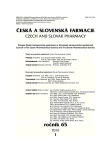-
Medical journals
- Career
Influence of the mesh of extrusion dies on the properties of cores intended for the preparation of pellets with controlled glucose release
Authors: Sylvie Pavloková; Aleš Franc; Jan Muselík; Dana Sabadková; Pavlína Kopecká; David Neumann
Authors‘ workplace: Ústav technologie léků, Farmaceutická fakulta Veterinární a farmaceutická univerzita ; Dětská klinika 1. LF UK a FN, Hradec Králové, Česká republika 2
Published in: Čes. slov. Farm., 2016; 65, 22-27
Category: Original Articles
Overview
Diabetes mellitus and its compensation are accompanied by serious complications. One of them is hypoglycaemia, which occurs in patients treated with insulin and/or certain peroral antidiabetics. Hypoglycaemic episodes can be prevented by a dosage form with controlled release of glucose. The pellet cores of four compositions and three different sizes corresponding to the diameter of extrusion screen mesh (0.6, 0.8, and 1.0 mm) were prepared for this purpose. The cores contain 75–80% of glucose combined with one of the following osmotically or swellable active agents: croscarmellose sodium (ADS), a mixture of microcrystalline cellulose and carmellose sodium Avicel RC 591 (RC), polyethylene glycol 6000 (PEG), and carboxymethyl starch (CMS). The cores were prepared by extrusion-spheronization and are intended for subsequent coating by a semipermeable membrane based on ethylcellulose. The aim of the work was to statistically evaluate the results of the physical evaluation of the pellets which were prepared and evaluated in previously published papers. The results are processed in the form of a meta-analysis using principle component analysis. The physical characteristics of the individual pellet sizes were different among themselves. Although the same compositions and manufacturing methods were used for all the pellets sizes, the cores produced through a 0.6 and 0.8 mm mesh screens showed similar properties while the properties of cores produced through a 1.0 mm mesh screen were rather different.
Key words:
hypoglycemia • delayed release • glucose • principal component analysis PCA • meta-analysis of data
Sources
1. American Diabetes Association Workgroup on Hypoglycaemia. 2005.
2. Fisher M., Heller S. R. Hypoglycaemia in clinical diabetes. 2nd ed. Chichester, UK: John Wiley & Sons 1999.
3. Fanelli C. G., Porcellati F., Pampenelli S., Bolli G. B. Insulin therapy and hypoglycaemia: the size of the problem. Diabetes Metab. Res. Rev. 2004; 20(2), 32–42.
4. Ryan C., Gurtunca N., Becker D. Hypoglycemia: a complication of diabetes therapy in children. Pediatr. Clin. North Am. 2005; 52, 1705–1733.
5. Franc A., Dvořáčková K., Muselík J., Žvaková M., Slováková V., Vetchý D., Sabadková D., Neumann D., Goněc R. Formulation of cores for the controlled release of glucose for prevention of hypoglycemia in diabetes patients. Čes. slov. Farm. 2014; 63, 206–212.
6. Heng P. W., Chan L. W., Chew S. H. Mechanism of pellet coat rupture and its effect on drug release. Chem. Pharm. Bull. 1999; 47(7), 939–943.
7. Sabadková D., Franc A., Muselík J., Neumann D. Coated pellets based on delayed release glucose as prevention of hypoglycemic episodes. Acta Pharmaceut. 2016 (v tisku).
8. Franc A., Muselík J., Sabadková D., Neumann D. Preparation of pellets with controlled release of glucose as prevention of hypoglycaemia in paediatric patients. Eur. J. Pharm. Sci. 2015; 75, 72–80.
9. R Core Team. R: A language and environment for statistical computing. R Foundation for Statistical Computing, Vienna, Austria. 2015. https://www.r-project.org/
10. Franc A., Sabadková D., Neumann D., Pavloková S., Kopecká P., Muselík J. Interdiction of hypoglycemia in diabetic children by multiparticulate dosage form with controlled glucose release. Pharm. Dev. Technol. 2015; 1–8.
11. Council of Europe. European Pharmacopoeia, 8th edition. Council of Europe, Strasbourg 2013.
12. Rabišková M. Technologické parametry lékových mikroforem, jejich význam a metody jejich stanovení. Čes. slov. Farm. 1996; 45, 177–179.
13. Rabišková M., Masteiková R., Chalupová Z., Dvořáčková K. Lékové formy a biofarmacie: II. Brno: Veterinární a farmaceutická univerzita 2009.
14. Podczeck F., Rahman S. R., Newton J. M. Evaluation of a standardised procedure to assess the shape of pellets using image analysis. Int. J. Pharm. 1999; 192, 123–138.
15. Chopra R. F., Podczeck J. M., Alderborn G. The influence of pellet shape and film coating on the filling of pellets into hard shell capsules. Eur. J. Pharm. Biopharm. 2002; 53, 327–333.
16. Rhodes C. T., Porter S. C. Coatings for controlled-release drug delivery systems. Drug. Dev. Ind. Pharm. 1998; 24, 1139–1154.
17. Saary M. Joan. Radar plots: a useful way for presenting multivariate health care data. J. Clin. Epidemiol. 2008; 61(4), 311–317.
18. Wehrens, R. Chemometrics with R. 1st ed. Heidelberg: Springer 2011.
Labels
Pharmacy Clinical pharmacology
Article was published inCzech and Slovak Pharmacy

2016 Issue 1-
All articles in this issue
- The relationship of lipid imbalance and chronic inflammation mediated by PPAR
- Oral films as perspective dosage form
- Influence of the mesh of extrusion dies on the properties of cores intended for the preparation of pellets with controlled glucose release
- Antimicrobial, antiparasitic and anticancer properties of Hibiscus sabdariffa (L.) and its phytochemicals: in vitro and in vivo studies
- Potential anticancer agent hypericin and its model compound emodin: interaction with DNA
- Development of a spectrophotometric method for carmoisine determination in quality control of equipment cleaning
- Thin-layer chromatography application for the standardization of Sophora flowers
- Czech and Slovak Pharmacy
- Journal archive
- Current issue
- Online only
- About the journal
Most read in this issue- Oral films as perspective dosage form
- Antimicrobial, antiparasitic and anticancer properties of Hibiscus sabdariffa (L.) and its phytochemicals: in vitro and in vivo studies
- The relationship of lipid imbalance and chronic inflammation mediated by PPAR
- Influence of the mesh of extrusion dies on the properties of cores intended for the preparation of pellets with controlled glucose release
Login#ADS_BOTTOM_SCRIPTS#Forgotten passwordEnter the email address that you registered with. We will send you instructions on how to set a new password.
- Career

